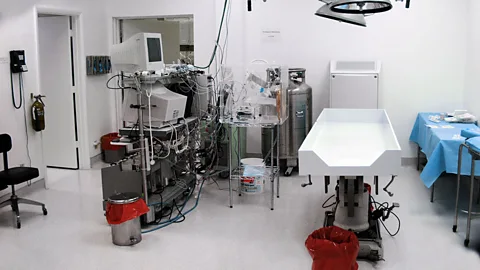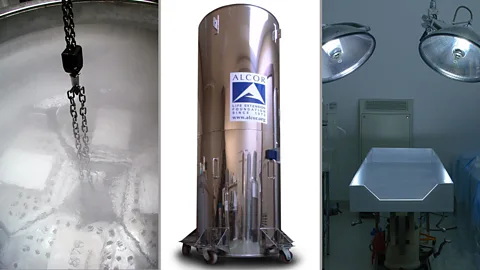Cryopreservation: ‘I freeze people to cheat death’


Max More will have his brain frozen after he dies, and he’s not alone. Rose Eveleth asks him why he signed up – and how the strange procedure of cryopreserving bodies actually works.
In 1972 Max More saw a children’s science fiction television show called Time Slip that featured characters being frozen in ice. He didn’t think much about it until years later, when he started hanging out with friends who held meetings about futurism. “They were getting Cryonics magazine,” he says, “and they asked me about it to see how futuristic I was. It just made sense to me right away.”
More is now the President and Chief Executive officer of Alcor, one of the world’s largest cryonics companies. More himself has been a member since 1986, and has decided to opt for neuropreservation – just deep freezing the brain – over whole body preservation. “I figure the future is a pretty decent place to be, so I want to be there,” he says. “I want to keep living and enjoying and producing.”
Cryopreservation is a darling of the futurist community. The general premise is simple: medicine is continually getting better. Those who die today could be cured tomorrow. Cryonics is a way to bridge the gap between today’s medicine and tomorrow’s. “We see it as an extension of emergency medicine,” More says. “We’re just taking over when today’s medicine gives up on a patient. Think of it this way: 50 years ago if you were walking along the street and someone keeled over in front of you and stopped breathing you would have checked them out and said they were dead and disposed of them. Today we don’t do that, instead we do CPR and all kinds of things. People we thought were dead 50 years ago we now know were not. Cryonics is the same thing, we just have to stop them from getting worse and let a more advanced technology in the future fix that problem.”
Of course, the premise of cryonics also makes it essentially untestable. Nobody has ever tried to bring a human back to life after preservation. While researchers working on ‘suspended animation’ are finding that they can cool a living being down to appear apparently dead before reviving them, freezing a body for decades is a different matter. More points to studies in which scientists have studied the preservation of cells and tissues and even worms, but scaling that up to a full human body isn’t a trivial proposition. But whether the science is there or not, people are being frozen in liquid nitrogen with the hope of seeing some distant tomorrow.
Death plan
Alcor’s members come from all over the world. Ideally, More says, the company will have an idea of when their members are going to die. Alcor maintains a watch list of members in failing health, and when it seems as though the time has come they send what they call a “standby team” to do just that – stand by the person’s bed until they die. “It could be hours, days, we’ve gone as long as three weeks on standby,” More says.
Once the person in question is declared legally dead, the process of preserving them can begin, and it’s an intense one. First, the standby team transfers the patient from the hospital bed into an ice bed and covers them with an icy slurry. Then Alcor uses a “heart-lung resuscitator” to get the blood moving through the body again. They then administer 16 different medications meant to protect the cells from deteriorating after death. As they note on their website, “Because cryonics patients are legally deceased, Alcor can use methods that are not yet approved for conventional medical use.” Once the patient is iced up and medicated, they move them to a place for surgery.

The next step includes draining as much blood and bodily fluids as possible from the person, replacing them with a solution that won’t form ice crystals – essentially the same kind of antifreeze solution used in organ preservation during transplants. Then a surgeon opens up the chest to get access to the major blood vessels, attaching them to a system that essentially flushes out the remaining blood and swaps it with medical grade antifreeze. Since the patient will be in a deep freeze, much of the preparatory work involves trying to ensure that ice crystals don’t form inside the cells of the body.

Once the patient’s veins are full of this antifreeze, Alcor can begin to cool them down by about one degree Celsius every hour, eventually bringing the body down to -196C after about two weeks. Eventually the body finds its final home for the foreseeable future: upside down in a freezer, often alongside three others.
This is the ideal scenario. But it doesn’t always go this way – if a patient hasn’t told Alcor they were sick, or if they die suddenly, the process can be delayed for hours or days. In one of their most recent cases, an Alcor member committed suicide, and Alcor staff had to negotiate with police and the coroner to get access to the body. The longer the wait between death and preservation, the more cells will decay, and the harder it will be to resurrect and cure the patient, More says.

If this all sounds like a lot of risk for a slim reward, it might be. More is the first to admit that cryonics comes with no guarantees. “We don’t know for sure, there’s a lot of things that can go wrong,” he says. It’s possible that Alcor and companies like it are simply storing a lot of dead bodies in liquid nitrogen. But he also claims that cryonics is unlike a lot of other futuristic technology. “There’s no fundamental physical limit to be able to repair tissues,” he says, “it’s not like time travel.” The science of tissue regeneration is steadily advancing. But nobody really knows when they’ll be able to wake these patients up, or if they’ll be able to at all. When forced to take a guess at how long we’ll have to wait for medicine to catch up to save Alcor’s members More put the number between 50 and 100 years. “But it’s really impossible to say. We probably don’t even know what repair technology would be used.”
As of today, 984 people are signed up with Alcor to be preserved when they die. People who sign up for Alcor’s services pay a yearly membership fee of about $770. When it comes time to actually preserve a person the cost ranges from $80,000 to preserve just the brain up to $200,000 to preserve the whole body. Some of that money, More says, goes into a patient care trust fund that keeps the facilities running and the bodies inside preserved for the long haul. And More is quick to point out that many patients get a life insurance policy that factors in the cost of their eventual freezing. “It’s not only something for the rich,” he says, “anybody who can afford an insurance policy can afford this.”

A video tour of Alcor, recorded by Nikola Danaylov of singularityweblog.com
Most members, More says, are somewhat squeamish about the actual process of cryopreservation – but they see it as a means to an end. “We don’t want to be cryopreserved – we hate the idea in fact. The idea of sitting in a tank of liquid nitrogen not able to control our own destinies is not appealing. But it’s a lot more appealing than the alternative, to be digested by worms or incinerated – that doesn’t appeal to us at all.”
